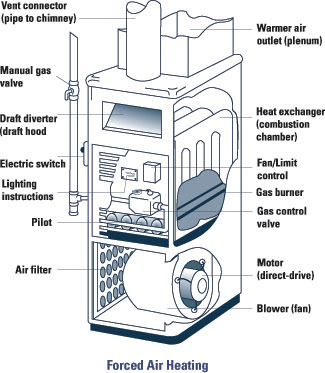Natural Gas Furnace
Save energy and money with a natural gas furnace. Buy a high efficiency model and save even more.
Today's natural gas furnaces can be up to 92% efficient or higher, helping you lower your heating bills for years to come. They provide reliable, even heat to keep your family warm and comfortable.
You may need a new furnace if...
You would like to upgrade the efficiency of your home heating system.
Your current system needs frequent repairs or doesn't start at the beginning of a season.
Your furnace is 15 years old or older. The life expectancy of a furnace is 15 to 20 years.
You recently bought your home and do not know how old or safe your furnace is. Schedule a professional heating system check in the summer or fall to ensure you are ready for winter.
Shopping for a new furnace...
A new furnace usually costs $2,100 or more and plays a big part in your family's comfort at home. Here are some shopping tips:
-
Consider the efficiency. A higher efficiency furnace may cost more to purchase, but it can save as much as 20% to 35% per year on your heating bills, depending on the equipment you buy.
-
Buy from a reputable dealer. Choose someone you can trust that sells quality brand furnaces — this is a big purchase.
-
Talk to friends and neighbors. You can learn a lot by asking people who have gone through the process of buying a furnace and lived with it for a few years.
-
Get estimates. Compare efficiencies and installation costs of various models.
-
Get educated. Become an educated shopper before you buy.
-
Look for "Design Certified" models. This is a certification from the
American Gas Association ensuring safety, reliability, and efficiency.
How a natural gas furnace works
Most homes have central heating systems which generate heat at a central point and distribute it by air, water, or steam to each room in the house. A furnace is a warm air central heating system that supplies heat to an air transfer system. Here's how it works:
Heated air rises from the furnace through large supply ducts.
Cool air returns to the furnace through cold air return ducts. The weight difference between warm and cool air keeps the air circulating.
Warm air is forced through supply ducts by a blower; it enters a room through registers or diffusers, then returns via a cold air duct to the furnace where it is filtered, reheated and recirculated.

Efficiency savings for natural gas furnaces
|
Old natural gas furnace efficiency | New natural gas furnace efficiency | First-year savings* |
Ten-year savings* |
| 65% | 80% | $183 | $1,830 |
| 65%** | 92% | $287 | $2,870 |
| 65% | 94% | $301 | $3,010 |
Safety and your natural gas furnace
- Keep furnace area clear of flammable liquids (gasoline, paint products, solvents or cleaners) and all combustible materials (newspaper, cardboard boxes or rags).
- Furnaces run longer during very cold weather to maintain the thermostat setting, so duct and register surfaces may be hot. Keep children away.
- If the pilot goes out, look for relighting instructions printed on the furnace. If it goes out repeatedly, call a qualified heating contractor.
- Prevent unsafe levels of carbon monoxide. Have your furnace and all fuel-burning equipment checked by a professional once a year to be sure it is operating safely and has sufficient air for proper combustion.
Learn more about carbon monoxide safety in
Natural Gas Safety.
Caring for your natural gas furnace
Home heating systems need periodic care to extend operating life, save energy, and increase efficiency. Use the following as general guidelines, but follow manufacturer's recommendations whenever possible.
Things you can do yourself...
- Check chimney and vent connector (the pipe between the furnace and the chimney). Replace if there are rust holes or corrosion.
- Oil pumps, blowers, and motors at least twice during the heating season. Some are permanently lubricated. Check manufacturer's instructions.
- Clean blower blades. Dust and dirt reduce their air capacity, causing overheating and fuel waste.
- For older models, check the V-belt and replace if worn or cracked. Newer models do not have belts.
- Check your filter at least once a month during the heating and cooling seasons. (More if you have cats or dogs.)
- If the pilot light goes out, look for relighting instructions printed on the furnace. If it goes out repeatedly, call a professional.
Call a professional when...
- Your heating system is not working properly. Signs include:
- Odors and/or irritation to your nose or eyes.
- Soot and carbon deposits on the burner, in the combustion chamber, on the floor near the furnace/boiler or below the draft hood opening.
- Buildup of dust, dirt or scale on burners and/or burner components.
- A yellow flame rather than a blue flame.
- Flame backing up and burning outside the combustion chamber.
- Excessive humidity or frost on windows or walls. - Your natural gas burners need cleaning or adjusting.
Energy-saving tips
Here are some steps you can take to save energy and help lower your heating bills:
Find more ways to save energy with
efficiency resources and tips.